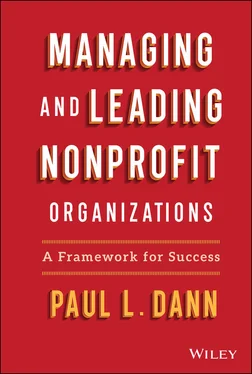Paul L. Dann - Managing and Leading Nonprofit Organizations
Здесь есть возможность читать онлайн «Paul L. Dann - Managing and Leading Nonprofit Organizations» — ознакомительный отрывок электронной книги совершенно бесплатно, а после прочтения отрывка купить полную версию. В некоторых случаях можно слушать аудио, скачать через торрент в формате fb2 и присутствует краткое содержание. Жанр: unrecognised, на английском языке. Описание произведения, (предисловие) а так же отзывы посетителей доступны на портале библиотеки ЛибКат.
- Название:Managing and Leading Nonprofit Organizations
- Автор:
- Жанр:
- Год:неизвестен
- ISBN:нет данных
- Рейтинг книги:4 / 5. Голосов: 1
-
Избранное:Добавить в избранное
- Отзывы:
-
Ваша оценка:
- 80
- 1
- 2
- 3
- 4
- 5
Managing and Leading Nonprofit Organizations: краткое содержание, описание и аннотация
Предлагаем к чтению аннотацию, описание, краткое содержание или предисловие (зависит от того, что написал сам автор книги «Managing and Leading Nonprofit Organizations»). Если вы не нашли необходимую информацию о книге — напишите в комментариях, мы постараемся отыскать её.
Managing and Leading Nonprofit Organizations: A Framework For Success
Managing and Leading Nonprofit Organizations: A Framework For Success
Managing and Leading Nonprofit Organizations — читать онлайн ознакомительный отрывок
Ниже представлен текст книги, разбитый по страницам. Система сохранения места последней прочитанной страницы, позволяет с удобством читать онлайн бесплатно книгу «Managing and Leading Nonprofit Organizations», без необходимости каждый раз заново искать на чём Вы остановились. Поставьте закладку, и сможете в любой момент перейти на страницу, на которой закончили чтение.
Интервал:
Закладка:
The notion of a leadership toolbox is an important one. Leadership performed well requires that you develop a set of capabilities that can be drawn upon to help advance your goals and objectives. Each of these capabilities have their own nuances and require that you become skilled at implementing them. As we discuss in Chapter 2, being successful in leadership requires practice, similar to the way using a tool requires that you know its purpose and that you have worked enough with it to understand what it offers as well as its limitations, not to mention the level of skill that you bring to its use.
 Build Your Leadership Toolbox!
Build Your Leadership Toolbox!
Many of us can recall a former leader or manager (you may have one at this very moment!) who knew how to use only one or two tools of what should have been a complete toolbox for leadership practice. The leader who has only a hammer is ill equipped for the complexity we find in today's organizations—not all problems are nails in need of a hammer. At the risk of over‐using the metaphor, try hiring someone to build your house and see how it goes if they know only how to hammer things. It is not a pretty sight, and the desired goal will be destined to fail. It's comical when you think about a carpenter who can manage only the swing of a hammer, pounding away in an endless effort to cut a board or tighten a screw, only to fail in the end. We laugh at the image, but the truth is that many managers and leaders find themselves with only one or two tools that they have become relatively proficient with. Let's not stick to the same few tools and instead commit ourselves to building a proper set of tools to help advance your capabilities to effectively lead.
The goal of this book is to help you develop your leadership and managerial capabilities. The toolbox seen here contains tried‐and‐true tools. Like the toolbox metaphor, the idea behind this book is to share tried‐and‐true strategies that will assist you throughout your leadership practice within the nonprofit industry. By using tried‐and‐true strategies, you will be prepared to refine and develop your leadership toolbox.
Now it is true that some might criticize the use of tried‐and‐true tools as turning a blind eye to what is new and emerging. The intent here is not to exclude new and emergent strategies—in fact we will explore some of what is new and upcoming—but rather to impart what has been learned as successful strategies for advancing leadership over the course of four decades of successful nonprofit leadership.
This book also endeavors to help you heighten your capacity for what I call scholar/practice‐based leadership. The book draws upon what is written about leadership practice in today's complex organizations and importantly delves into practice‐based strategies and techniques. In this way we integrate what is known in the literature about best practices within nonprofit leadership while exploring practical strategies to ensure the efficacy of your leadership practice. It is important to know what works and how your practice is grounded in what is written about effective leadership as you strive to support the people you serve and the organizations you work for.
Together we work through the lessons learned with an eye toward supporting the development of your leadership practice. Chapter 2identifies the importance of building your practice, not only for yourself but also for those around you. Contrary to the traditional Western Cultural lens, leadership is not a lone wolf activity where a single actor ensures a successful outcome but rather an activity that, when done well, requires processes that engage the skills of the individual, the entire team, and the overall organization.
In Chapter 3we explore some key leadership models that you can use to identify your own leadership approach. This is a 1,000‐foot flyover and could be a book in and of itself. The goal here, however, is to provide you with some sense of where your leadership practice either lives or will live as you grow into your leadership style and approach. You will also read about some classic conceptual frames for leadership that I have found to be extremely helpful. Like our box of tried‐and‐true leadership tools, many of the classic frames for leadership practice have true value as we develop our skills and capabilities.
In Chapter 4we delve into strategies for impacting organizational culture. Here we encounter the conceptual frame of simplexity where many of the strategies are at once “simple and complex.” As in the earlier chapters, Chapter 4will provide you with an opportunity to enhance your leadership practice as well as the practice of those around you within the organization. The organization's culture is critical to the success of any nonprofit agency and so we give the importance of establishing a positive organizational culture its due in this chapter, returning to these important ideas as appropriate throughout the book.
Chapter 5explores the practice of Generative Leadership, where leadership development is achieved through leadership in action. Generative Leadership provides you with a way to advance your own, your team's, and your organization's capacity to grow effective leadership. In many ways this becomes the secret sauce for you and your organization's continued success, so be ready to make use of the strategies that are imparted here.
In Chapter 6we underscore the benefits that can come from engaging our most precious resource: our employees. Through performance management and employee engagement we unlock more of the strategies that have proven to be extraordinarily successful when working to advance leadership practice within and across the organization. Simplexity abounds here as well, particularly when you consider how simple yet critically important the ideas are for ensuring your team or organization's ability to achieve its nonprofit mission.
Chapter 7explores the use of effective systems to realize desired outcomes for your organization. Thoughtful development and use of systems are critical to ensuring that you can achieve the goals and objectives identified as part and parcel of your organization's purpose, mission, and vision. As you read this chapter, you will see the importance of ensuring that you have built a dynamic and thoughtful set of systems that complement your structure and the values, beliefs, and vision that you hold essential to achieving the organization's mission.
I would be remiss if this book did not also explore the topic of change and the importance of establishing a leadership practice that has the capacity for change management. Chapter 8does just that by discussing various strategies to ensure effective change management. In today's complex organizations, having a leadership practice that is equipped to manage and guide your team and organization through change is essential. We take time to ensure that the capacity for change management is multilayered by going beyond the prowess of the individual leader to change management at the team and the organizational level.
In addition, do not forget the importance of conflict management, which is explored in detail within Chapter 9. Conflict is a part of everyday organizational life and when it's managed well, it can become a source of growth and development for you, your team, and the entire organization.
In Chapter 10I share some of the techniques and strategies I have used to engage and advance my team. Many of the strategies here are drawn from years of experience supervising and motivating team members to be their best. Your ability to lead effectively is directly connected to your capacity to develop a strong team. Given this, I think you will find this chapter quite helpful.
Читать дальшеИнтервал:
Закладка:
Похожие книги на «Managing and Leading Nonprofit Organizations»
Представляем Вашему вниманию похожие книги на «Managing and Leading Nonprofit Organizations» списком для выбора. Мы отобрали схожую по названию и смыслу литературу в надежде предоставить читателям больше вариантов отыскать новые, интересные, ещё непрочитанные произведения.
Обсуждение, отзывы о книге «Managing and Leading Nonprofit Organizations» и просто собственные мнения читателей. Оставьте ваши комментарии, напишите, что Вы думаете о произведении, его смысле или главных героях. Укажите что конкретно понравилось, а что нет, и почему Вы так считаете.











